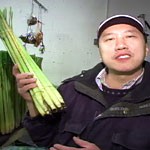2007年VOA标准英语-Business Increasing for Largest Refugee Group i
时间:2019-01-12 作者:英语课 分类:2007年VOA标准英语(四月)
By Deborah Block
St. Paul, Minnesota
23 April 2007
The Midwest U.S. state of Minnesota is home to the largest Hmong community outside Asia. They originally came from Laos as refugees 2 after the Vietnam War. At least half of Minnesota's 60,000 Hmong live in St. Paul, the state's capital and second-largest city. The only indoor Hmong shopping center in the area sells many items that remind the Hmong of home. VOA's Deborah Block has the story from St. Paul.
The International Market Place is a vibrant 3 shopping center with a wide variety of goods and services, ranging from food to jewelry 4 to a hair salon 5. Nou Vang owns the market along with her husband and operates a food booth 6. She says the shopping center is a place where Hmong people can enjoy themselves.
"They can make friends in here. They can meet friends in here. And that's why a lot of people come here and they can see a lot of business around here too. So they can get food. They can get anything they want to."
The market also has a store that sews traditional Hmong clothes. Nou's husband, Toua Xiong, says one piece of clothing is worn to attract women. "Walking with the noise I'm a man of money. So girls come on. That's how I got my wife. It makes me look a lot more handsome."
Many in Minnesota's Hmong community arrived in the late 1970s and 80s after being sponsored 7 by local humanitarian 8 and religious groups. They were mostly poor, uneducated farmers from Laos who had backed the U.S. during the Vietnam War and had fled to Thailand.

Pheng Yang
Twenty-four-year-old Pheng Yang was in a refugee 1 camp in Thailand and came to the United States when he was 10. He prints photos from a computer. He says the International Market was a good place for him to start his own business because many Hmong like to shop there.
"Hmong people usually like an outside flea 9 market, because in Thailand the streets were filled with markets and I think this is a good idea of what it is like back there," he says.
There are more than 150 vendors 10 at the market. They say the shopping center helps them to make a modest living. Some do not speak English well and lack skills to get other jobs. Most vendors work long hours, seven days a week.

Neng Lee sells lemon grass
Neng Lee sells produce, some imported from Asia. "The lemon grass -- the Hmong people like to eat this and they cook it with chicken," he tells us.
During the warmer months in Minnesota, he rents a plot of land from a farmer to grow some vegetables. "When I lived in my country (Laos) my parents took me to the farm every day. So that's why I like to do the same thing my parents did."
Du Yang sells typical Hmong kitchen knives. He says business has been good because he has regular Hmong customers. “In this shopping mall, you can expose your product to more people because people travel to Minnesota every weekend from throughout the USA because they have relatives here."
Some customers visit a traditional tea bar where free hot drinks are handed out. The idea is that if you like the tea, you may buy some to take home. Customer Zao Her says many Hmong believe tea helps improve some health problems. "This tea is pretty good for people who have high blood pressure and for diabetes 11 and something like that."
Today, there are approximately 400 Hmong-owned businesses in the St. Paul area. Business owner Bao Vang says Hmong business is continuing to grow. She says she is living the American dream."Who would have thought an illiterate 12 10-year-old girl who came to America in 1980, who couldn't read or write, who couldn't communicate, could be somebody like me who owns multiple 13 businesses?"
She says many Hmong are enterprising people who like having their own business. She says having a business is a big achievement since so many of them came to the U.S. with so little.
- The refugee was condemned to a life of wandering.这个难民注定要过流浪的生活。
- The refugee is suffering for want of food and medical supplies.难民苦于缺少食物和医药用品。
- The UN has begun making airdrops of food to refugees. 联合国已开始向难民空投食物。
- They claimed they were political refugees and not economic migrants. 他们宣称自己是政治难民,不是经济移民。
- He always uses vibrant colours in his paintings. 他在画中总是使用鲜明的色彩。
- She gave a vibrant performance in the leading role in the school play.她在学校表演中生气盎然地扮演了主角。
- The burglars walked off with all my jewelry.夜盗偷走了我的全部珠宝。
- Jewelry and lace are mostly feminine belongings.珠宝和花边多数是女性用品。
- Do you go to the hairdresser or beauty salon more than twice a week?你每周去美容院或美容沙龙多过两次吗?
- You can hear a lot of dirt at a salon.你在沙龙上会听到很多流言蜚语。
- Where can I find a telephone booth?我在哪儿可以找到电话亭?
- Let's walk around to each booth.我们到每个摊子转一转吧!
- The exhibition was sponsored by the Society of Culture. 这个展览会是由文化学会主办的。 来自《现代英汉综合大词典》
- The company sponsored several TV programs. 这家公司赞助了几个电视节目。 来自《简明英汉词典》
- She has many humanitarian interests and contributes a lot to them.她拥有很多慈善事业,并作了很大的贡献。
- The British government has now suspended humanitarian aid to the area.英国政府现已暂停对这一地区的人道主义援助。
- I'll put a flea in his ear if he bothers me once more.如果他再来打扰的话,我就要对他不客气了。
- Hunter has an interest in prowling around a flea market.亨特对逛跳蚤市场很感兴趣。
- The vendors were gazundered at the last minute. 卖主在最后一刻被要求降低房价。
- At the same time, interface standards also benefIt'software vendors. 同时,界面标准也有利于软件开发商。 来自About Face 3交互设计精髓
- In case of diabetes, physicians advise against the use of sugar.对于糖尿病患者,医生告诫他们不要吃糖。
- Diabetes is caused by a fault in the insulin production of the body.糖尿病是由体內胰岛素分泌失调引起的。
- There are still many illiterate people in our country.在我国还有许多文盲。
- I was an illiterate in the old society,but now I can read.我这个旧社会的文盲,今天也认字了。